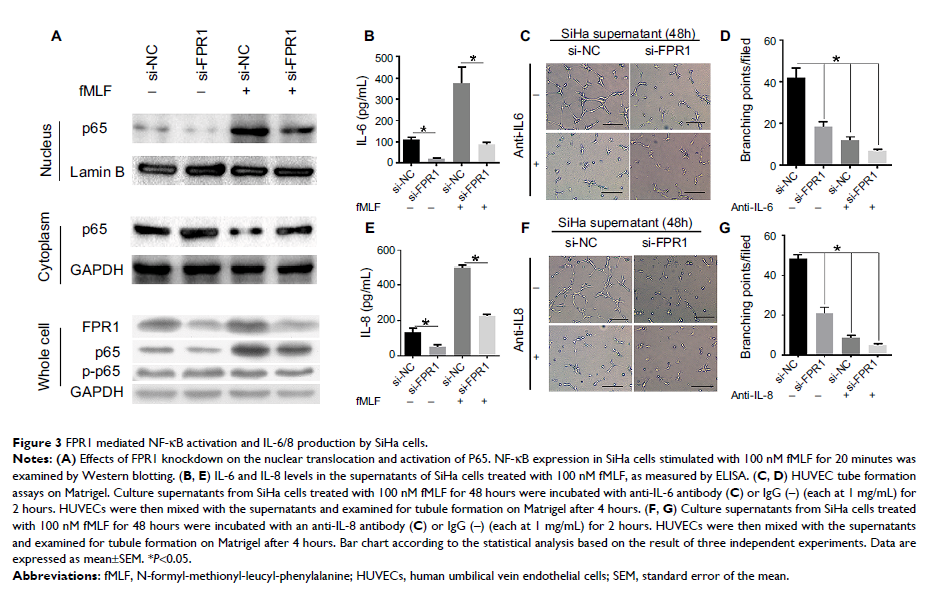9 1 2 3 6
论文已发表
注册即可获取德孚的最新动态
IF 收录期刊
- 2.6 Breast Cancer (Dove Med Press)
- 3.9 Clin Epidemiol
- 3.3 Cancer Manag Res
- 3.9 Infect Drug Resist
- 3.6 Clin Interv Aging
- 4.8 Drug Des Dev Ther
- 2.8 Int J Chronic Obstr
- 8.0 Int J Nanomed
- 2.3 Int J Women's Health
- 3.2 Neuropsych Dis Treat
- 4.0 OncoTargets Ther
- 2.2 Patient Prefer Adher
- 2.8 Ther Clin Risk Manag
- 2.7 J Pain Res
- 3.3 Diabet Metab Synd Ob
- 4.3 Psychol Res Behav Ma
- 3.4 Nat Sci Sleep
- 1.9 Pharmgenomics Pers Med
- 3.5 Risk Manag Healthc Policy
- 4.5 J Inflamm Res
- 2.3 Int J Gen Med
- 4.1 J Hepatocell Carcinoma
- 3.2 J Asthma Allergy
- 2.3 Clin Cosmet Investig Dermatol
- 3.3 J Multidiscip Healthc

FPR1 可介导人宫颈癌细胞的致瘤性
Authors Cao G, Zhang Z
Received 6 August 2018
Accepted for publication 23 October 2018
Published 16 November 2018 Volume 2018:10 Pages 5855—5865
DOI https://doi.org/10.2147/CMAR.S182795
Checked for plagiarism Yes
Review by Single-blind
Peer reviewers approved by Dr Amy Norman
Peer reviewer comments 4
Editor who approved publication: Dr Antonella D'Anneo
Purpose: The
present study aimed to investigate the role of FPR1 and the downstream
effectors such as NF-κB and IL-6/8 in the development of cervical cancer.
Patients and methods: FPR1
protein expression was detected via immunohistochemical staining in tissue microarrays
containing cervical cancer tissues from 185 patients. Following FPR1 silencing
in SiHa cells using lentiviral siRNA delivery, biological characteristics and
tumor formation were evaluated in vitro and in vivo, respectively.
Phosphorylated NF-κB levels were detected by Western blotting, while IL-6 and
IL-8 secretion were detected by ELISA in both FPR1 knockdown and control SiHa
cells. Human umbilical vein endothelial cell tube formation assays were
performed to evaluate the angiogenesis-promoting ability of IL-6 and IL-8
secretion in FPR1 knockdown and control SiHa cells. Neovascularization,
proliferation and apoptosis markers were detected by immunohistochemical
staining to analyze the tumorigenic role of FPR1.
Results: Immunohistochemistry
of cervical cancer tissues from 185 patients revealed high FPR1 expression
levels in patients with advanced-stage disease and/or poor prognosis. Compared
with control cells, cervical cancer cells in which FPR1 was silenced exhibited
inhibition of cell invasion, migration and proliferation and higher levels of
apoptosis. NF-κB was inhibited in FPR1 knockdown in SiHa cells. IL-6/8
upregulation by FPR1 activation stimulated angiogenesis. FPR1 deficiency
inhibited the tumorigenicity of cervical cancer cells in nude mice. FPR1, IL-6,
IL-8, CD31 and Ki67 levels were all reduced, whereas cleaved caspase-3 was
upregulated, in the FPR1 knockdown group compared with the levels in the
control group.
Conclusion: High FPR1
expression was associated with advanced stage and poor prognosis in cervical
cancer patients. FPR1 activation induced NF-κB nuclear translocation to promote
cervical cancer development through the upregulation of IL-6 and IL-8
expression. Inhibiting FPR1 activity may thus have potential therapeutic value
in cervical cancer patients.
Keywords: cervical
cancer, FPR1, IL-6, IL-8
